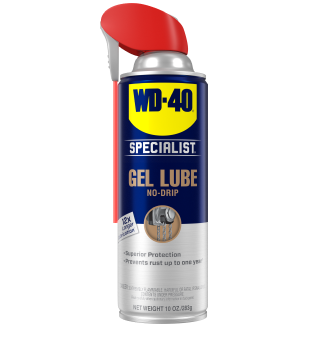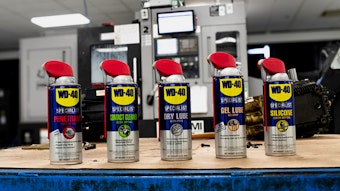How Silicone Based Lubricants Simplify Maintenance
How Silicone Based Lubricants Simplify Maintenance
<< BackSilicone lubricants have slipped into the hearts of professionals looking for superior lubrication and effectiveness. In this piece we will look at what silicone based lubricants are, their water repellent properties and their thermal stability and non-reactive characteristics. We will further explore the benefits of using these lubricants, their usefulness in various industries and conclude our discussion by unpacking the best practices for using silicone based lubricants.
Looking for a powerful silicone-based lubricant that packs a punch? Get WD-40 Specialist® Silicone in a retailer near you.
Understanding Silicone based lubricants
What are silicone based lubricants?
Lubricants are substances that reduce the friction coefficient between two surfaces allowing easier movement. Silicone based lubricants are made with silicone oils as the main ingredient. They are well known for their exceptional lubricating properties and are highly resistant to water. They offer excellent thermal stability and are non-reactive, making them suitable and safe for a wide range of applications.
These lubricants are distinguished from their less slippery counterparts by the following characteristics:
Water Repellency:
These lubricants are hydrophobic, meaning they repel water. This allows them to protect items that are vulnerable to rust. This characteristic makes them ideally suited for application in high-moisture environments.
High Thermal Stability:
These lubricants perform exceptionally well across a wide range of temperatures, including extreme conditions such as scorching heat (500 ⁰F) or freezing cold (-100 ⁰F).
Non-Reactivity:
These lubricants are safe for use on most materials including rubber, plastic and metal. They will not react to the surface of these components and will not cause any degradation of the surface material.
Get your hands on WD-40 Specialist® Silicone and experience its water repelling and stable characteristics firsthand.
Benefits of Silicone Based Lubricants
Silicone based lubricants’ water repellency, high thermal stability and non-reactive nature make them the ideal lubrication solution for many applications. The hydrophobic nature and unique chemical structure allow it to be effective in environments where oil-based lubricants are unsuitable, examples include underwater machinery and high-temperature applications such as diesel engines and industrial equipment.
The various materials used in these industries, including plastic, rubber and metal are compatible with these lubricants. They can be used on gaskets and rubber seals preventing drying and cracking and door hinges enabling easier movement. This broad compatibility and applicability make silicone based lubricants an essential tool in any operation.
Another added benefit is that these lubricants are environmentally friendlier than other oil based lubricants, reducing the environmental impact traditionally associated with lubricants. The reduced environmental impact is accredited to the non-toxicity of these lubricants and need for less frequent application due to their longevity.
WD-40 Specialist® Silicone does not contain Volatile Organic Compounds (VOCs) and is 50-state VOC compliant. VOCs are chemicals that contribute to air pollution and pose health risks. Being compliant with VOC regulations adds to the safety of using WD-40 Specialist Silicone Lubricant, because this lubricant can be used in confined spaces and areas with poor ventilation.
Let’s explore some of the environments in which these lubricants are suitable.
For safe, reliable and long-lasting lubrication, WD-40 Specialist Silicone is the way to go. Find it in a retailer close to you.
The Application of High Performance Lubricant for Equipment Maintenance
Silicone based lubricants are used to maintain equipment and machinery in all types of industries. WD-40 Specialist Silicone lubricant can be used on steel cables, pulleys, guide rails, valves, linkages, and hinges. It provides long-lasting lubrication compared to its competitors ensuring long-term performance, smooth operations, and the prevention of downtime. Using this lubricant as part of your regular equipment maintenance helps save money in the long run.
In industrial settings the efficiency and long-lasting nature of silicone based lubricants are essential in day-to-day maintenance tasks by ensuring the longevity of machinery and equipment. With its hydrophobic nature the silicone lube helps protect machinery and equipment against rust and corrosion, once again extending your operation’s lifespan.
Best Practices for Using Silicone Based Lubricants
After reading our best practices on using silicone based lubricants you can wave your stubborn equipment problems goodbye.
- To get started grab a can of WD-40 Specialist® Silicone, personal protective equipment (PPE), and a clean cloth or paper towel.
- Firstly, clean the surface of the hinge to ensure there is no dust or debris, so that the lubricant can easily adhere to the problem area.
- Next shake the can of WD-40 Specialist Silicone for at least 10 seconds to ensure a homogenous mixture.
- After shaking the container, aim the spray nozzle toward the intended component you would like to lubricate. In this example, aim the spray nozzle towards the desired area. WD-40 Specialist Silicone comes with Smart Straw® Sprays 2 Ways® delivery system for easy and accurate application. For pinpoint application flip the straw up for a stream of lubricant or down for a wide-angle spray.
- After applying a generous amount of lubricant, open and close the door a few times to allow the lubricant to penetrate the hinge.
- Wipe off the excess lubricant from the hinge and enjoy silent and easy movement.
Remember to regularly inspect any equipment regarding the need for lubrication to ensure that your equipment remains in tip-top shape. Signs to look out for indicating that lubrication is required include difficulty in the movement of equipment or machinery, increased noise levels and visible wear.
Ensure to not over- or under-apply the lubricant. Too much silicone based lubricant will attract dust and debris, causing more friction and wear over time, while too little will result in inadequate lubrication. If you apply as directed by the manufacturer’s instructions, you should be all set.
And finally, always ensure that the material of the equipment or part you intend to lubricate is compatible with silicone based lubricants. Most parts and equipment that are not made of silicone will be compatible with this high-performance lubricant, and those made of silicone typically are not.
Silicone based lubricants are powerful, easy to use, better for the environment and compatible with most equipment and tools. By using these powerful lubricants you will slip away from any unforeseen maintenance situations.
Check out our full line of WD-40 Specialist® products today.
FEATURED PRODUCTS
WANT TO GET MORE TIPS AND TRICKS?
SUBSCRIBE TO THE NEWSLETTER


